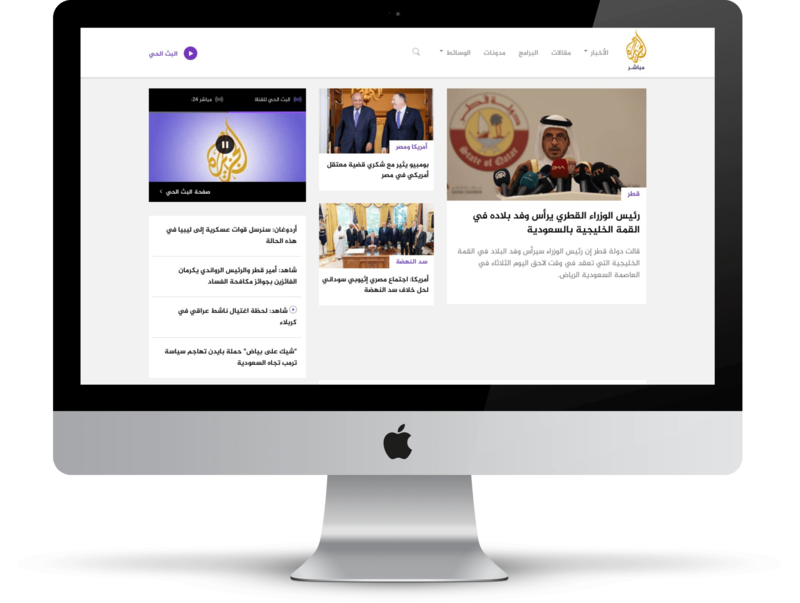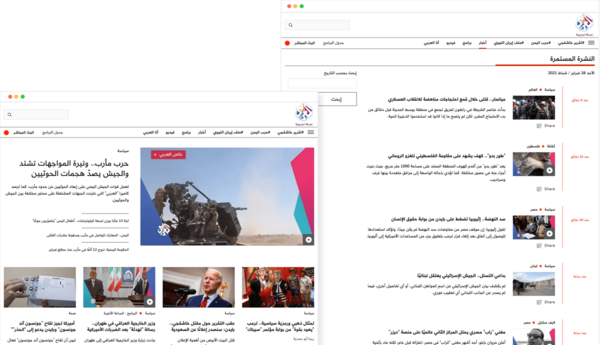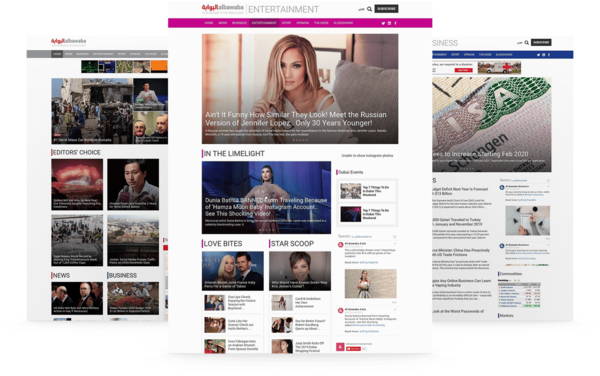
Al Jazeera Media Network is a global provider in news and media broadcasting. Launched in 1996, the channel broadcasts around the world 24-hours a day, 7 days a week from its base in Doha, Qatar. It distributes content in multiple languages, genres, and formats on a wide range of conventional and digital platforms, connected devices and via commercial partners.
Al Jazeera Media Network was facing surging user volumes and platforms and required an efficient enterprise publishing platform that could unify several different content streams and support a complicated editorial workflow, allowing network-wide collaboration and search.
Al Jazeera partnered with Vardot and other Drupal-specialized companies for the delivery of a global, multilingual, unified Content Management System (CMS) platform to streamline and modernize the creation and personalized delivery of news on the newly released Drupal 8 platform.
Design, UI, and UX
The redesign process was conducted and orchestrated by Al Jazeera team. Several workshops to analyze the best user experience for content presentation and curation were conducted, resulting in a simplistic, modern, well-studied, and enhanced new design. The new design focused on content discoverability on all devices. It is a major enhancement over the legacy site marking a new chapter for Al Jazeera Mubasher.
Building the CMS
The unified CMS Al Jazeera has built, plays a central role as their main tool for content production, curation, and distribution. The CMS was built using the unified CMS built on Drupal 8, which offers pre-configured and defined content structure, configuration, and base theme.
Given the fast pace of the 24/7 newsroom, editorial execution was prioritized – enabling quick content creation and publishing.
Utilizing the Bootstrap theme as a base theme, the design was converted to a mobile-first dynamic template using Twig markup. The site is optimized for all screen sizes, all modern browsers, and all mobile operating systems.
A base theme for Al Jazeera Mubasher was developed, encapsulating the standard design language for Al Jazeera’s future websites to be built using this unified platform. It provides a nice clean starting point with many common elements already styled, in a way that is easy to improve upon.
Video Repository
Al Jazeera uses Brightcove Video Cloud for its online video solution. This video hosting and publishing solution allows Al Jazeera to efficiently add, manage and publish professional-quality video to audiences on any device.
The Brightcove module was implemented and customized to meet the specific needs of the editorial staff.
Editorial Tools
Powerful editorial customizations and features were implemented. The focus was to make the platform appealing to the editorial staff, and allow them to publish in the shortest amount of time. Features such as Drag & Drop media uploads, sidebar search for related content, and many editorial tools were implemented. This made the process of updating and adding content a quick and simple task for staff who don’t need high-level technical knowledge.
The CMS establishes a central code base for innovation, it was built to standardize the editorial workflow processes across the whole network.
Workbench Moderation was also implemented to enable content creators and editors to manage the content publishing workflow. It improved the editorial workflow by simplifying the interface for users and allowed easy configuration of user permissions based on organization structure.
The Entityqueue module was also implemented, allowing the creation of queues of any entity type and helping promote and order featured content. This has helped Al Jazeera editors to sort and promote content much more easily. Content locking was installed to prevent concurrent editing and it is configurable to lock by content and format type. It also prevents losing content by accident, for example, a user exiting without saving.
Migration from Legacy CMS
The legacy site was running on a homegrown CMS built on .NET. The migration process was carried between Al Jazeera team and Vardot via XML feeds.
Vardot used the Drupal 8 Migrate API to successfully import the content from the legacy CMS to the new unified platform.
With iterative migrations, Drupal 8 Migrate API offered unmatched out-of-the-box support for creating core Drupal objects such as nodes, users, files, terms, and comments.
SEO
Search engine optimization (SEO) for news and media websites is certainly one of the most important factors that lead to Drupal. Vardot took care of all on-site optimizations for search engines. Metatags, markups, Twitter cards, structure data, XML sitemaps and many other tools for full search engine optimization were implemented.
It was important as well to consider the 80,000+ indexed links on search engines from the old site. Redirects from old URLs to new ones generated by Drupal was implemented during the migration process, to prevent a loss of traffic to the new site from existing organic, indexed content.
Security
Security was one of the most critical parts of building the platform. A platform of such wide reach gets regular hacking attempts that must be mitigated. Therefore the platform needed to guarantee secure, reliable, and robust security policies and transactions.
Vardot designed an appropriate platform architecture around protecting user data and mitigating security risks.






